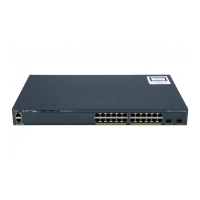If the switch fails before returning a CoA-ACK to the client, the process is repeated on the new active switch
when the request is re-sent from the client. If the switch fails after returning a CoA-ACK message to the client
but before the operation has completed, the operation is re-started on the new active switch.
Related Topics
Session Identification, on page 57
Stacking Guidelines for Session Termination
No special handling is required for CoA Disconnect-Request messages in a switch stack.
Stacking Guidelines for CoA-Request Bounce-Port
Because the bounce-port command is targeted at a session, not a port, if the session is not found, the command
cannot be executed.
When the Auth Manager command handler on the stack master receives a valid bounce-port command, it
checkpoints the following information before returning a CoA-ACK message:
•
the need for a port-bounce
•
the port-id (found in the local session context)
The switch initiates a port-bounce (disables the port for 10 seconds, then re-enables it).
If the port-bounce is successful, the signal that triggered the port-bounce is removed from the standby stack
master.
If the stack master fails before the port-bounce completes, a port-bounce is initiated after stack master
change-over based on the original command (which is subsequently removed).
If the stack master fails before sending a CoA-ACK message, the new stack master treats the re-sent command
as a new command.
Stacking Guidelines for CoA-Request Disable-Port
Because the disable-port command is targeted at a session, not a port, if the session is not found, the command
cannot be executed.
When the Auth Manager command handler on the stack master receives a valid disable-port command, it
verifies this information before returning a CoA-ACK message:
•
the need for a port-disable
•
the port-id (found in the local session context)
The switch attempts to disable the port.
If the port-disable operation is successful, the signal that triggered the port-disable is removed from the standby
stack master.
If the stack master fails before the port-disable operation completes, the port is disabled after stack master
change-over based on the original command (which is subsequently removed).
If the stack master fails before sending a CoA-ACK message, the new stack master treats the re-sent command
as a new command.
Catalyst 2960-XR Switch Security Configuration Guide, Cisco IOS Release 15.0(2)EX1
OL-29434-01 61
Configuring RADIUS
RADIUS Change of Authorization

